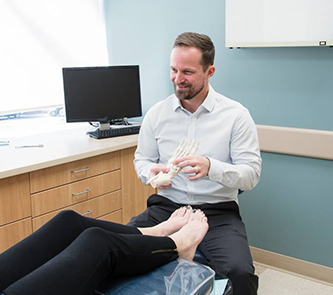Shared Decision-Making
There are many gratifying aspects to my job,
- Getting patients feeling better quickly
- Having same day treatments available
- Seeing a variety of foot ailments making two days never the same
But one of my favorite things is how rarely I have to utter the words “today we HAVE to do __________treatment” to a patient. Podiatry offers so many opportunities for shared decision-making (the practice of an informed patient participating in treatment decisions) and as a physician I really enjoy the highly collaborative treatment planning.
When see a new patient my goal is to not only give them a timely and accurate diagnosis but to tailor a treatment plan that works for them. Most of my patients know that following all the questions I ask regarding their symptoms comes, “What do you do for work? What is your day to day like?” I enjoy getting to know each of my patients and arming them will a full gamut of options to help treat their foot pain.
Let’s take plantar fasciitis (or heel pain) for example. I can see upwards of 10 patients a day, either new or in follow-up for heel pain, and each of them are at a different stage in their treatment and have chosen different treatment paths. Some are in physical therapy, others for a cortisone injection, or our EPAT (shockwave) therapy and one post-operatively after a plantar fascial release. None of these patients I treated the same because every one of them has different goals and lifestyles.
By giving my patients all the treatment options available to them I can create a truly patient focused treatment regime, aimed at getting each individual person better on their terms. Every day I am delighted to work with my patients and actively involve them in the decision making process regarding their foot pain versus saying, “this is what you have to do”.
I believe that an informed patient is a happier and in the end healthier patient and many industry executives agree…
Real Word Example: Why Value-Based Care Must Include Shared Decision-Making : Shared decision-making is a key patient engagement strategy, but not yet widespread. By Sara Heath (February 26, 2018) – via, patientengagementhit.com
Shared decision-making integrates the patient into the healthcare process and gives the patient more claim in her wellness journey.
Shared decision-making has shown to reduce preventable hospital readmissions among cardiac patients by at least 19 percent, and can also decrease patient anxiety and healthcare costs.
“Although shared decision-making has been around for quite a few years, and although there is a significant evidence basis about the expected outcomes of shared decision-making interactions, it is really more the exception than the rule in clinical practice today,” Goldbach said in a recent interview with PatientEngagementHIT.com (Peter Goldbach, Chief Medical Officer for Rite Aid’s RediClinic and Health Dialog).
“There are islands of excellence that do exist, specifically people that have taken an interest in shared decision-making,” Goldbach added, making a nod to SDM researchers and specialists.
Some medical professionals do believe they are practicing shared decision-making, but when Goldbach spends more time with the provider and breaks down the details of shared decision-making, it becomes clear that the art has not yet been perfected.
The healthcare industry landscape has never been conducive to integrating shared decision-making, Goldbach explained. Although shared decision-making has fairly clear benefits, evolving healthcare initiatives such as emerging technologies and reporting requirements have made it hard for providers to adopt the technique.
“Shared decision-making has not been part of providers’ education,” Goldbach noted. “It’s not part of the current culture. And people who practice medicine today are beset by a very busy, difficult environment where they have a lot of new requirements and a lot of new operating systems distracting them. That is a difficult environment to bring in new ways of working with patients.”
The time is ripe for more widespread adoption of shared decision-making, Goldbach added. Healthcare professionals are becoming more comfortable with new technologies, and strategies have emerged to enhance, not distract from, shared decision-making.
Shared decision-making has a considerable human component to it – educating and partnering with patients for better care is an important part of the patient experience and puts patients in control of their own health.
We support and encourage collaborative medicine at Northeast Foot and Ankle. It is our goal to offer patient focused care and to encourage our patients to make informed decisions about their treatment options.
Pay Your Bill
Make a payment online through our payment portal or Care Credit!
Portsmouth Office
14 Manchester Square, Suite 250
Portsmouth, NH 03801
Nashua Office
17 Riverside Street, Suite 205
Nashua, NH 03062
Website Hosted by SC Digital



